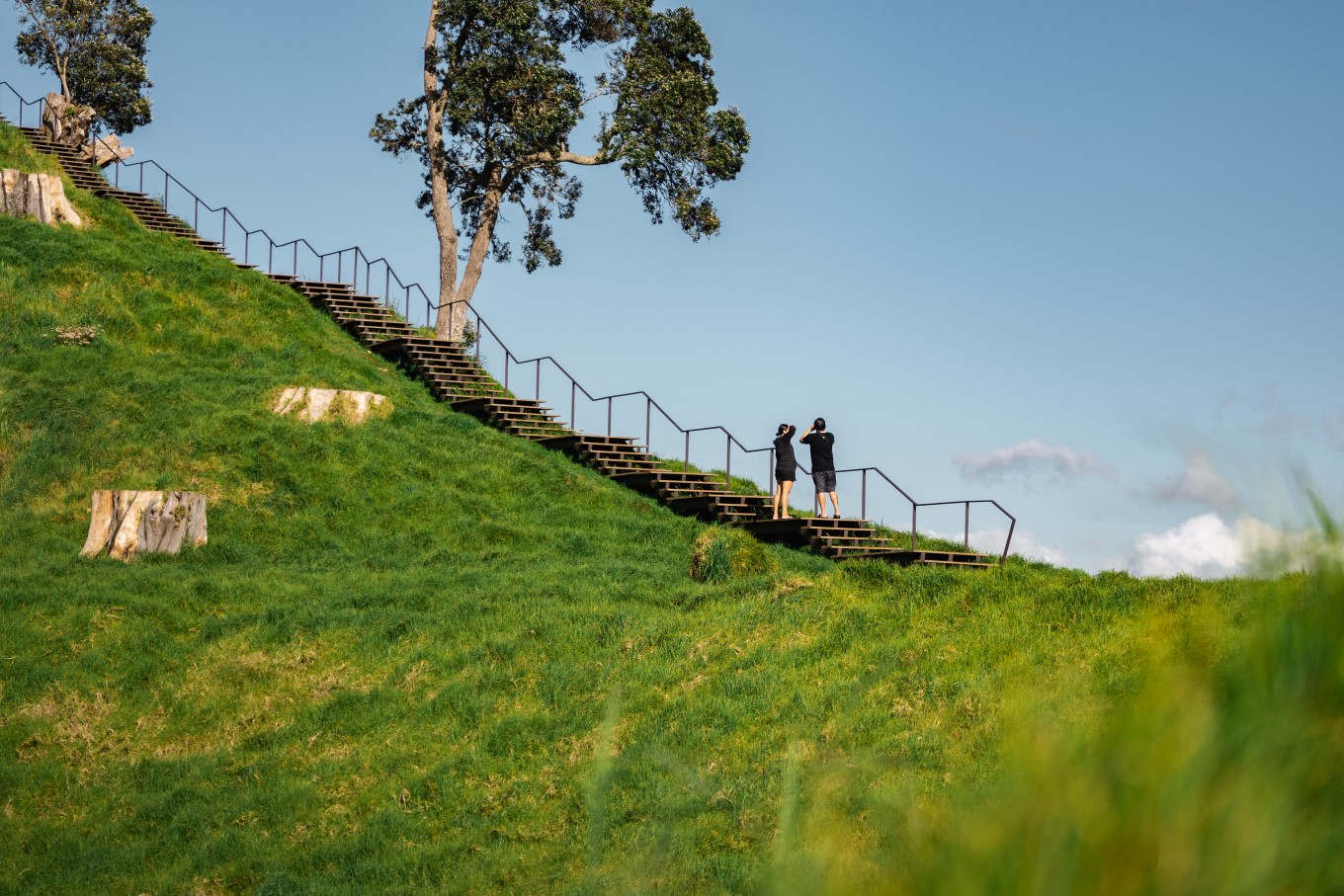Living in Auckland is to live among giants. As one of the most densely populated volcanic cities in the world, you’re never far from one of the distinctive green cones that shape our region’s geography and identity.
There are 53 dormant volcanoes across the region, not all of them your typical “volcano” shape. Some of them have been quarried, some are flat and one is a lake.
Fourteen of them are the tūpuna (ancestral) maunga and are regarded as historically significant areas of settlement. They are places of important spiritual, ancestral and cultural identity to the 13 mana whenua of Tāmaki Makaurau and are looked after by the Tūpuna Maunga Authority – a co-governance partnership between mana whenua, Auckland Council and a representative from the Crown.

A new staircase leads to the summit of Te Pane o Mataoho / Te Ara Pueru / Māngere Mountain.
“The deep cultural history of the Tāmaki Makaurau maunga and their continued living connections set them apart from all other volcanic landscapes in the world,” says Paul Majurey, chairperson for Tūpuna Maunga Authority.
“Over the centuries, as Māori society established in Tāmaki Makaurau, the maunga became valued for their highly strategic locations and were developed into the most extensive network of monumental and defendable settlements throughout the Pacific,” says Paul. “The tūpuna maunga enabled Tāmaki Makaurau to become an unparalleled centre of Māori social organisation and the most active nexus of complex inter-tribal relationships and connections, transit, and trade in Māori society.”
Today our maunga continue to be significant to the people of Auckland, with some of them, such as Maungawhau / Mt Eden, receiving more than one million visitors per year. But to love our maunga is to protect our maunga, and this is how the Tūpuna Maunga Authority is looking after these iconic places.
Building new pathways to protect the past
New boardwalks and steps have been installed across some of the different tūpuna maunga, protecting these ancient sites while making them more accessible to visitors.
“Prior to the Authority, many of the tracks were subject to deferred maintenance and in a state of disrepair. This meant that there was lots of damage to the maunga caused by people walking off track and water scouring the tracks that ultimately caused erosion on the maunga and damage to the archaeological sites,” says Paul.
Something every Aucklander should traverse is the boardwalk that runs right around the tihi (summit) of our highest maunga, Maungwhau / Mt Eden. It offers visitors extensive views across the city and into the sacred crater, known to mana whenua as Te Kapua Kai a Mataaho (‘the food bowl of Mataaho’, the deity responsible for volcanic activity). The award-winning feature includes platform landings adjacent to the different terraces.
“The Tūpuna Maunga Authority has worked to a number of principles, such as avoiding digging where possible, building up rather than digging into the ground, and avoiding archaeology. The Authority has built significant knowledge on building sensitive archaeological sites,” says Paul. “We are very proud of the work we have done on the tracks and believe they offer a world-class walking experience on the maunga. This new infrastructure will be helpful for the future bid to UNESCO for World Heritage status.”
Another significant upgrade includes a new staircase and track on Te Pane o Mataoho / Te Ara Pueru / Māngere Mountain. This maunga was once an important defensive pa site – driving along the motorway from Auckland Airport, you can still see the heavy terracing, while on the east of the crater you can see rows of rectangular storage pits. In 2022, a whānau atea (community gathering space) opened here – it’s a place for people to come together, play and explore. There is a basketball court, community hāngī pit, a skate park and a māra hūpara (traditional Māori playground) with tūpekepeke (upright logs for jumping practice), whirinaki (climbing log), wiwi wawa (grassed play mounds). A space for everyone, there are also wheelchair-accessible play elements.
Another maunga that has a new boardwalk is Te Tātua a Riukiuta / Big King – this maunga’s name refers to Riukiuta, a tohunga (priest) of the Tainui waka / canoe. From the summit you can spot neighbouring maunga including Maungawhau / Mt Eden and Ōwairaka / Te
Ahi-kā-a-Rakataura / Mt Albert. It was once one of three adjoining volcanic cones (thus the name of the suburb Three Kings), but the other two were quarried away. While it’s important to keep your dog on a lead and clean up after them at all the maunga, at Te Tātua a Riukiuta / Big King there is an off-leash area where your dog can run free.
Nearby Ōwairaka / Te Ahi-kā-a-Rakataura / Mt Albert also boasts a smart new series of steps and aggregate paths that lead up to the summit, while other areas on this beloved mountain have been permanently closed off to protect important archaeological features.

New steps up Owairaka / Mt Albert have ensured that important archaeological features of this maunga will be preserved.
Play your part
You can help to protect and respect our maunga by keeping to the tracks. “When people walk off track, they can create ‘desire lines’ – long carved out routes that impact on cultural fabric and archaeology, “ says Paul. Always pick up after your dog and make sure your dog is on a leash in on-leash areas and take your rubbish with you or use any bins provided. They might have fiery pasts, but it’s prohibited to light fires or let off fireworks on maunga. All maunga are smoke and alcohol-free places.




